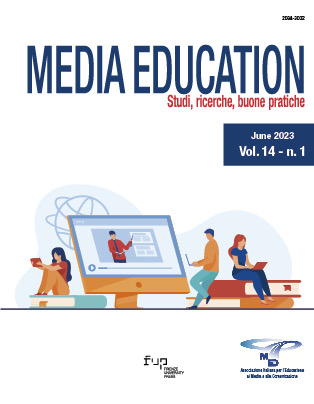Published 2023-05-31
Keywords
- Distance learning,
- Video education,
- pandemic
Copyright (c) 2023 Stefano D'Antuono, Mauro Mola, Edoardo Nepote, Alberto Parola

This work is licensed under a Creative Commons Attribution-NonCommercial-NoDerivatives 4.0 International License.
Abstract
This article intends to present the educational experience in relation to the transition from the face-to-face education oriented to the writing and audiovisual production to distance education, carried out during the lockdown in the winter 2020/21, due to the Covid-19 pandemic. The impossibility of carrying out the activity in presence has dictated unpublished conditions not only about the selection of the arguments to be deepened, but also with reference to the different phases of video production, which in this article is conceived as a form of epistemic writing, or an interweaving of languages that allows children to express ideas, to represent their school and extrascolastic reality and to vary their way of observing and interpreting their existences. Due to the new circumstances, the project was adapted. However, it can be considered satisfactory, although the school was not yet ready to host types of remote training with the simultaneous presence of different classes. In this context, it was not easy to manage the process of involvement of the students. The atypical role of the teacher facilitator has led to an on time learning path, which has also provided for the creation of work groups with flexible activities, partly at school and partly at home.
References
- Agosti, A. (2006). Gruppo di lavoro e lavoro di gruppo: aspetti pedagogici e didattici. Franco Angeli.
- Bao, W. (2020). COVID-19 and online teaching in higher education: A case study of Peking
- University. Human Behavior and Emerging Technologies, 2, 113-115, https://doi.org/10.1002/hbe2.191. DOI: https://doi.org/10.1002/hbe2.191
- Beaunoyer, E., Dupéré, S., & Guittona, M.J. (2020). COVID-19 and digital inequalities: Reciprocal impacts and mitigation strategies. Computers in Human Behavior, 111, 106424, https://doi.org/10.1016/j.chb.2020.106424. DOI: https://doi.org/10.1016/j.chb.2020.106424
- Chiu, T.K.F. (2021). Applying the self-determination theory (SDT) to explain student engagement in online learning during the COVID-19 pandemic. Journal of Research on Technology in Education, 1-17, https://doi.org/10.1080/15391523.2021.1891998. DOI: https://doi.org/10.1080/15391523.2021.1891998
- European Commission (2020). Educational inequalities in Europe and physical school closures during Covid-19. Science for policy briefs, 4/2020, 3.
- González-Betancor, S.M., López-Puig, A.J., & Cardenal, M.E. (2021). Digital inequality at home. The school as compensatory agent. Computers & Education, 168(6),104195, https://doi.org/10.1016/j.compedu.2021.104195. DOI: https://doi.org/10.1016/j.compedu.2021.104195
- Hartnett, M.K. (2016). The importance of motivation in online learning. In: Motivation in Online Education (pp. 5-32). Springer, https://doi.org/10.1007/978-981-10-0700-2_2. DOI: https://doi.org/10.1007/978-981-10-0700-2_2
- Kavanagh, L., Reidsema, C., Smith, N., & Hadgraft, R. (Eds) (2017). The Flipped Classroom Practice and Practices in Higher Education. Springer Singapore, https://doi.org/10.1007/978-981-10-3413-8. DOI: https://doi.org/10.1007/978-981-10-3413-8
- Iivari, N., Sharma, S., & Ventä-Olkkonen, L. (2020). Digital transformation of everyday life – How COVID-19 pandemic transformed the basic education of the young generation and why information management research should care?. International Journal of Information Management, 55, https://doi.org/10.1016/j.ijinfomgt.2020.102183. DOI: https://doi.org/10.1016/j.ijinfomgt.2020.102183
- Mascheroni, G., Saeed, M., Valenza, M., Cino, D., Dreesen, T., Zaffaroni, L.G., & Kardefelt Winther, D. (2021). Learning at a Distance Children’s remote learning experiences in Italy during the COVID-19 pandemic. UNICEF.
- Monteduro, G. (a cura di) (2021). Sotto esame. La vita degli studenti universitari al tempo del Covid-19. Hoepli.
- Musburger, R. (2012). Single-Camera Video Production. Taylor & Francis. DOI: https://doi.org/10.4324/9780080964904
- Schaefer, M.B., Schamroth Abrams, S., Kurpis, M., Abrams, M., & Abrams, C. (2020). “Making the Unusual Usual:” Students’ Perspectives and Experiences of Learning at Home during the COVID-19 Pandemic. Middle Grades Review, 6(2), Article 8, in Internet: https://scholarworks.uvm.edu/mgreview/vol6/iss2/8
- Souza Araujo, C., Magno, G., Meira Jr., W., Almeida, V., Hartung, P., & Doneda, D. (2017).
- Characterizing Videos, Audience and Advertising in Youtube Channels for Kids, International Conference on Social Informatics, 2017, https://doi.org/10.48550/arXiv.1707.00971
- Statista Research Department (2020). Share of online school classes due to the outbreak of coronavirus (COVID-19) in Italy in 2020, by region, 11/2020, www.statista.com/statistics/1106536/online-school-classes-due-to-coronavirus-in-italy.
- Tang, Y.M., Chen, P.C., Law, K.M.Y., Wu, C.H., Lau, Y.Y., Guan, J., He, D., & Ho, G.T.S. (2021). Comparative analysis of Student’s live online learning readiness during the coronavirus (COVID-19) pandemic in the higher education sector. Computers & Education, 168:104211, https://doi.org/10.1016/j.compedu.2021.104211 DOI: https://doi.org/10.1016/j.compedu.2021.104211
- Tur-Viñes, V., Núñez-Gómez, P., González-Río, M.J. (2018). Kid influencers on YouTube. A space for responsibility. Revista Latina de Comunicación Social, 73, 1211-30. DOI: https://doi.org/10.4185/RLCS-2018-1303
- Urh, M., Vukovic, G., Jereb, E., & Pintar, R. (2015). The Model for Introduction of Gamification into E-learning in Higher Education. Procedia - Social and Behavioral Sciences, 197, 388-397, https://doi.org/10.1016/j.sbspro.2015.07.154 DOI: https://doi.org/10.1016/j.sbspro.2015.07.154
- Visco, W. (2019). Using pop culture to foster student understanding and engagement. The English Journal, 109(2), 84-91.

